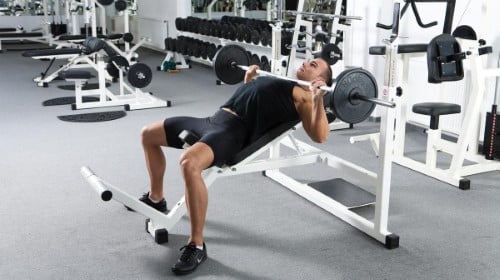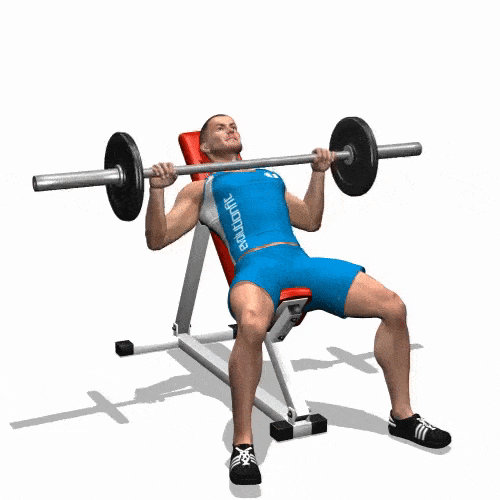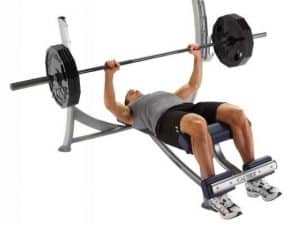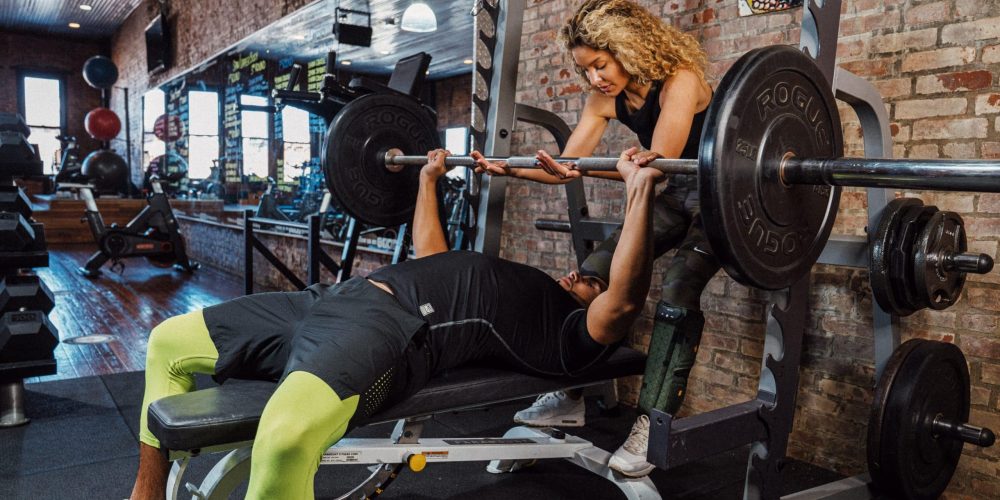Bench press ─ Both the incline and decline bench press build the upper body muscles, including the pectoral, front deltoid, and triceps muscles. It is one of the famous bodybuilding exercises among newbies and seasoned pros.
This result-oriented exercise enhances your chest, tones your arms, and gives you shapely shoulders. As a bonus, you will become stronger, allowing you to execute typical daily tasks.
Before diving deep into the comparison of incline and decline bench presses, consider these exercises.
Incline Bench Press
Using the flat bench press as a benchmark, the incline bench press gets its name from the raised angle of the bench by raising your head higher than your torso —anywhere from 15 to even 60 degrees. Due to head elevation, the incline bench press is generally easier to do for beginners.

Muscles Used
- » Pectoralis Major
- » Triceps Brachii
- » Anterior Deltoid
Along with more heavily targeting the upper pecs, the incline bench press also engages more of the anterior deltoids than the other two lifts. In fact, the higher the degree of the incline, the more of your shoulders will be used. With higher degree elevation, it resembles traditional shoulder exercises such as the shoulder press.
A slight change in grip, stance, or angle, can have varying effects. Do you want to get a shredded upper body? Go through our blog, “Shoulder Workout ideas”.
How To Do An Incline Bench Press
- » The key to this movement is to incline the bench to a 30-degree angle.
- » Lie on the adjusted bench with your feet flat on the floor.
- » With a shoulder-width, overhand grip on the barbell, dismount the weight from the overhead rack.
- » Lower it slowly on your chest — above your breasts and below your collarbone.
- » Push the weight by extending your arms to about two inches from the rack rests.
Perform eight to 10 repetitions for one complete set.

Decline Bench Press
The decline bench press is when the bench has been lowered from 15 to 30 degrees, lowering the head than the torso. At this angle, the lower pec is the focus of the bench.

Muscles worked
- The decline bench press forces your lower chest muscles and triceps to work. Regarding the movement mechanics, the primary benefit is that it’s much easier for your shoulders than the incline bench press. Since you’re pushing at a “down” angle, your shoulders don’t have to rotate as much, so there’s less stress on them.
How To Do Decline Bench Press
- » Adjust your bench press to a 30-degree decline from the horizontal position.
- » Once you have adjusted the bench press, lay on it with your feet flat on the floor.
- » Hold onto the bar with arms slightly wider than shoulder-width apart.
- » Unrack the bar by straightening your arms and moving them over your shoulders.
- » Lock your elbows afterward.
- » Slowly lower the bar until it touches your mid-chest area, slightly below the nipples.
- » Pause for a moment, then push it back into the starting position, locking your elbows.
- » Push the weight by extending your arms to about two inches from the rack rests.

Differences Between Incline And Decline Bench Press
- A study on incline versus decline bench presses showed that the 1 rep max of the decline for participants was 1.25 times their body weight. This was compared to an incline 1 rep max of 1.07 times the participants’ body weight.
- The decline bench press is also generally better at activating the pec as a whole than the incline bench press.
- The lower pecs are normally already developed much more than the upper pecs. It could be an important distinction a bodybuilder might make when trying to sculpt their chest, but for a gym enthusiast with a well-rounded training routine, this is most likely a non-issue.
- Due to the mechanics of the lift, there’s a much-decreased range of motion with the declined bench press. But since the lift is easier, it is a good way to add extra volume to your chest days after the shoulders, and upper pecs have been gassed out.
- The decline bench press is useful for bodybuilding or adding that little extra something to the bottom of your chest, but ultimately, you’ll probably be better off focusing on the incline.
- The incline bench press is not only safer but also a favorite when it comes to training the front upper body, along with the triceps. It will, most likely, garner more gains more efficiently than the decline bench press.
Verdict
Only The muscle groups they target differ between the incline and decline bench presses.
Do incline presses if you want a big, bulky upper body profile.
Do decline presses if you want the sharp line of demarcation undercutting your pecs.
If you want a balanced appearance, it’s not a matter of incline vs decline bench: Do Both.
Related Article:

Inner Chest Workout
The inner chest is a stubborn area to build since it has bigger and stronger fibers that require much more work to grow.









Comments 0